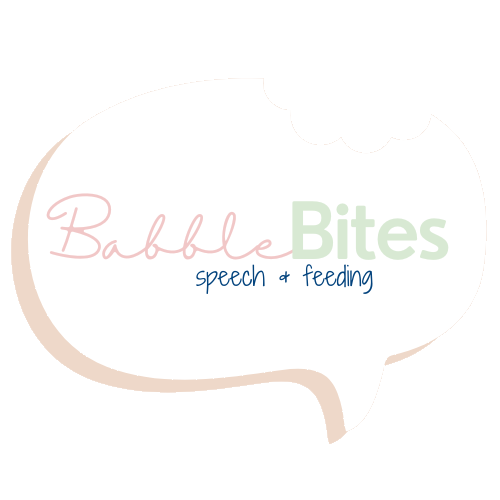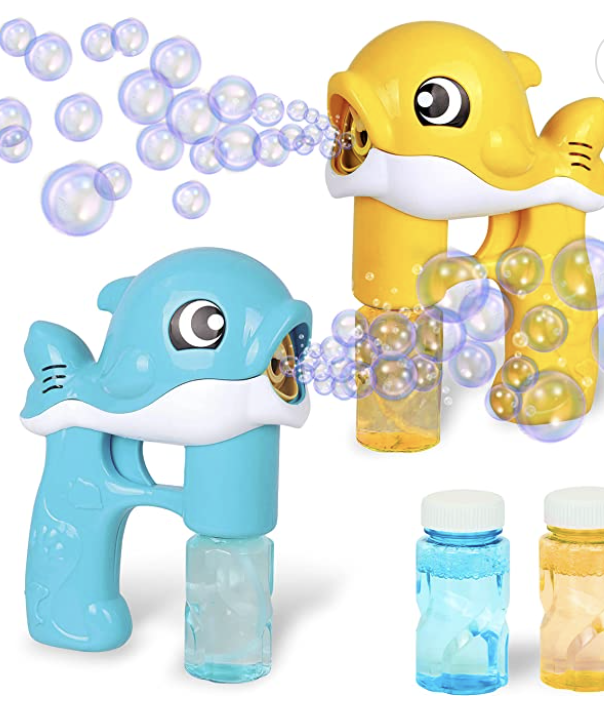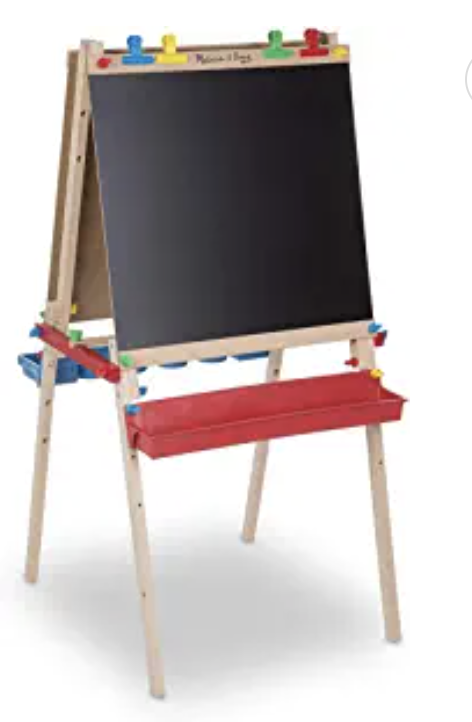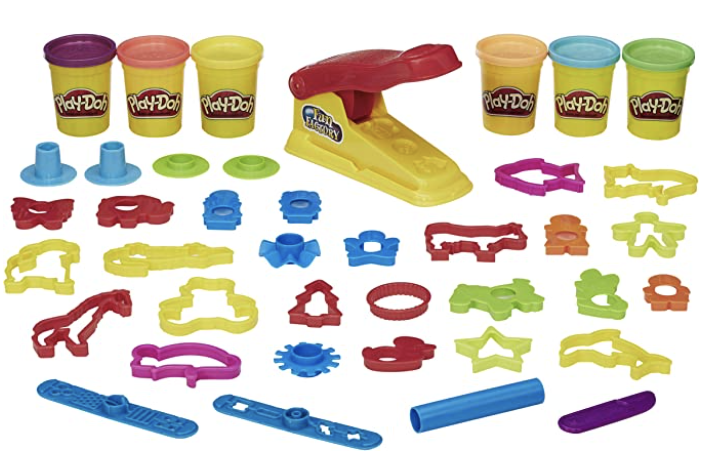Toy Guide for Toddlers
18 month olds to 3 year olds
These toys are great language builders! Children are supposed to know how to play with toys automatically, right? Not necessarily! Your child will strongly benefit from you playing together with them. You can model how to play with the toy, and then let your child’s imagination take over! This is one of the many reasons that playing with your child is extremely beneficial for their language development. Toys that are great for this age are ones that your child can interact with independently (e.g. physical play -- putting in/on, taking out/off, pushing), and can then be expanded on by an adult (e.g. adding in language of what you and your child are doing, creating requesting opportunities with pieces, helping to create 1-2 step play routines, and eventually expanding to pretend play). Learn more below about my favorite toys, from the perspective of a licensed speech-language pathologist, and how to use them to help develop your toddler’s language skills. Many of these toys can be introduced to your child as a toddler, and will still be appropriate into the preschooler years. Check out my Preschooler Toy Guide for 3+ year olds, too!
As an Amazon Associate, we earn from qualifying purchases. This means that at no additional cost to you, if you make a purchase through certain links on this site or any related social media platforms, we may make a small commission. We only feature products that we believe in and use ourselves. Your support means the world to us and allows us to host this website. Thank you!
Potato Head
Potato Head creates opportunities to work on identifying and labeling body parts, requesting, using descriptors (e.g. big, small, blue, brown), making phrases (2-3 word combinations), creativity, and pretend play. You can use the verbal choices language strategy if your child is working on using words or phrases to make requests. Potato Head also encourages the development of fine motor skills! Model words and phrases while building your Potato Heads together (e.g. Shoes on, push push push, two ears). Once you have built the Potato Heads, use them as you would any doll, action figure, or stuffed animal – have them talk to each other, go on adventures, have a tea party, or more!
Potato Head
Potato Head Family
Bus and People
Toy buses allow you to model simple 1-3 step play routines (e.g. 1. put people on the bus, 2. push the bus, 3. take people off the bus), and then build on these play routines to introduce pretend play (e.g. people talking to each other, talking about where the bus is going, pretending the kids are at school when they get off the bus). You can also work on using prepositions (on, off), action words (open, close, go, stop, walk, wait), and putting words together to make phrases (e.g. go bus, open door, people on). You can also give your child verbal choices to request who they want to put on the bus next (e.g. girl or boy?), or where you should put the people (e.g. on the bus or off the bus?).
*Tip: As a speech-language pathologist, I typically recommend toys that make little to no sounds electronically (there are some exceptions). I often leave the batteries out of toys like this, to encourage the child to do the talking, rather than the toy.
Melissa & Doug Wooden Bus
Little People Bus
Pretend Cutting Food
Pretend food, and especially food you can pretend to cut, is another favorite toy of mine for this age. It helps you teach your child functional food vocabulary words, action words (e.g. cut, chop, eat, put, give), colors, counting, matching, and food categories (e.g. fruits, vegetables). You can also work on your child understanding pronouns (e.g. Give me a piece, you take the banana). Your child can also work on fine motor skills pretending to cut the food. Build on 1-3 step play routines (e.g. 1. choose the food, 2. cut it, 3. put it back together), and expand into pretend play (e.g. pretending to eat the food, pretending to serve it or make a meal).
Wooden Fruits and Veggies
Plastic Cut Foods
Barn and Farm Animals
A barn and farm animals are a big hit with many toddlers. With barns and farm animals, you can model prepositions (e.g. in on, out, off), animal sounds (e.g. moo, baba, oink, neigh), and phrases (e.g. put cow in, in barn, take out, horse out). You can give your child verbal choices for them to choose what animal they want to put in the barn next. You can work on simple play routines (e.g. putting animals in and taking animals out of the barn), and expand to pretend play routines (e.g. animals eating, farmer bringing the animals food, animals talking to each other). You can also use the animals to sing “Old McDonald.” By holding up two animal choices while you sing, you allow your toddler to choose the next animal. Try this out with the cloze sentences strategy!
Little People Barn
Battat Barn
Little People Play Sets
You can start introducing these play sets to your child around 18 months of age, and they can grow with your child into their preschool years by continuing to expand on their imaginative play skills. Act out different simple scenarios with the characters with your toddler. Favorite play routines of mine include making the characters climb, sleep, talk to each other (e.g. saying “hi” and “bye-bye”), drive, or whatever other fun actions can be incorporated with each specific play set. There are so many options with these, find one that meets your little one’s interests! At this age, my favorites are ones that mirror real-life situations, such as the park, or house.
Tree House
Baby’s Room
Car and Ball Ramps
Car and ball ramps help create great language building opportunities. Model “ready, set…go!” each time you let the car or ball go down the ramp. After you’ve modeled this several times, say, “Ready, set…” and look and wait for your child to fill in “go!” before letting the car or ball go down the ramp! Learn more about how to use this strategy here. You can also let your toddler request which car they want next and practice their phrases (e.g. blue car, green ball). Narrate what you’re doing while you play with the car and ball ramp (e.g. I’m putting the green car on, the green car is on top, I’m going to let it go! Weeee, it’s driving fast! The green car is at the bottom, it stopped. It’s your turn!”). This toy is also great for practicing turn taking (your turn, my turn).
Wooden car ramp
Tall car ramp race track
Tot Tube
Nesting Blocks
Nesting blocks are a great way to practice simple and repetitive language. When stacking the blocks, each time you can model, “up,” “put on,” or “block on top.” You can also make a routine of stacking the blocks and then knocking them over and model, “fall down,” or, “kaboom!” Saying these same words and phrases each time you play are called verbal routines. Once these verbal routines are familiar, you can try using the cloze statement strategy, by letting your toddler fill-in-the-blank with the last word (e.g. “put…” “on”). I love the nesting blocks that come with associated items, such as vehicles or animals. Then your toddler can work on matching skills, and simple where questions (e.g. Where is the fire truck?). You can also give your toddler verbal choices to see which object they want to put in the blocks next (e.g. “pig or cow?).
Vehicle nesting blocks
Animal nesting blocks
Baby dolls
Baby dolls are great for all toddlers. You can help your toddler role-play real life scenarios that apply to your little one’s life, like feeding, sleeping, bath time, brushing hair and teeth, going for a walk, going to the doctor, changing clothes and diapers, and going shopping. You can model meaningful vocabulary words, such as, brush, eat, change, push, booboo, sleep, night night, go, hug, kiss, blanket, body parts, and more. Narrate what you and your child are doing with their baby doll, for example, “Baby is hungry, you’re putting baby in the high chair, you have the spoon and bowl, let’s feed her! Baby is eating.” You can also have your toddler follow some 2-step related directions, for example, “Get a diaper and change your baby,” or, “Find the bottle and give it to baby to eat."
Baby-Alive Doll
CoComelon Boo-boo Doll
Cleaning Toys
At this age, children love to imitate daily routines and actions. Cleaning toys like mini mops, mini vacuums, mini laundry machines, and mini sinks let your toddler act out these routine daily tasks. You can narrate what your child is doing, for example, “You are mopping the kitchen floor, mop mop mop, all clean!” You can also give your toddler routine directions, for example, “Daddy is going to vacuum now, go get your vacuum, we can vacuum together.” Many of these toys can elicit working on prepositions, such as in (e.g. put it in the laundry machine), under (e.g. sweep under the table), and out (e.g. take the dishes out of the sink).
Mop & Broom set
Toy Sink
Mini Vacuum
Push Car
Cars you can push your toddler in, or that they can push with their feet, provide great opportunities for both language and gross motor skills. You can model phrases such as, open door, sit in car, close door, buckle in, turn wheel, beep beep, turn around, go car, and stop car. There are even gas station accessories, so your toddler can pretend to fill up the gas tank! You can practice the verbal routine, “ready, set…” “go!” and have your toddler request “go” and “stop” if you are pushing the car.
Bubbles
Bubbles are almost always a hit with toddlers. Not only do most toddlers love bubbles, they also create opportunities for joint-attention (shift in eye gaze between an object and communication partner to communicate a shared experience), allow for turn-taking, use verbal routines, have easy to say words with early developing sounds (e.g. bubble, pop, more, up, down), and create lots of opportunities to use words for a variety of functions (e.g. comment, request, ask, respond). You can practice the verbal routine, “ready, set…” “go!” and have your toddler request “go” before you push the button, or blow the bubbles. You can also let your toddler practice requesting with single words (e.g. “more, “bubbles”) or phrases "(e.g. “more bubbles”). You can work on phrases, such as, “go bubbles,” “pop bubbles,” “bubbles up,” and “all gone.” This works great with bubble wands and bubble machines.
Puzzles
Not only do puzzles help with fine motor skills, they also provide great language opportunities. Depending on the puzzle, they can help teach early categorization skills (e.g. sea animals, fruits, shapes), which is important for learning and retaining new vocabulary. You can also have your toddler practice requesting with single words (12-18 months) (e.g. “more, “dog,” “apple”), phrases (18-24 months) (e.g. “more puzzle,” “want circle”), and sentences (2-3 years old) (e.g. “I need the watermelon,” “I want the horse please”). If your child is not yet making requests independently, you can use verbal choices. Hold up two pieces of the puzzle. Slightly shake and look at each choice while you label it, so your child knows which word goes with which object (e.g. “Cow or sheep?” “Whale or turtle”). Different puzzles are appropriate for different ages depnding on how easy it is to pick up the puzzle piece, if you match the piece to a picture or just by the shape, etc. so make sure to check the specific puzzle you choose for the recommended age.
Trains
Trains are a great toy to work on early problem solving skills (e.g. how to put the pieces together, how to put the characters on the train), and also provide fun opportunities to incorporate language. You can narrate what you and your toddler are doing, such as, “You’re putting the trains together, I’m putting Pluto on the blue train, Pluto is behind Goofy, you’re pushing the train, choo-choo, all aboard!” You can also work on simple 1-step directions with your toddler, such as, “Put Mickey on the train,” or 2-step directions, for example, “Take Donald off the train, then put Mickey on the train.” Trains are also a great way to work on simple play routines. For example, first put the train together, then put the characters on the train, drive the train around, then take everyone off of the train.
Fishing Toys
Fishing toys can be used to create simple play routines. First put the fish in the “water,” then catch a fish, take the fish off of the fishing pole, then put it in the bucket. You can use repetitive sentences, or verbal routines, while playing, such as, “I caught a ____,” “Take the ____ off,” and “Put the ___ in the bucket.” Try pausing after saying, “I caught a…” and see if your toddler fills in the blank! You can also have your toddler follow 1-step directions (e.g. “Catch the octopus”) and 2-step related directions (e.g. “Catch the shark then put it in the bucket”). Fishing is also a great opportunity to expand your toddlers single words into phrases, and phrases into sentences. For example, if your toddler says, “fish,” model, “blue fish,” or , “catch a fish.” If your toddler says, “red fish,” model, “I got a red fish.”
Art Easel
Painting, drawing, and doing chalk on an easel provide some great language opportunities. You can work on requesting what your child needs (e.g. “blue marker,” “green crayon,” “I need the blue”), as well as describing what they are drawing (e.g. “dot dot,” “up and down",” “circle circle around and around”). You can also describe what they drew to them (e.g. “It looks like a flower! I see your pink circles and the green line”). You can also see if they can trace your shapes, and even practice some early letter writing.
Playdoh
Playdoh creates so many opportunities to work on a variety of language skills and functions. You can label action words as you do the action, such as roll, squish, cut, give, open, get, push, break, make, stack, and rip, and model descriptive words such as colors, shapes, round, flat, and squishy. You can work on requesting with your child, such as to request help to open (e.g. help, help me, open, open blue please), to request what color they want next (e.g. green, want blue, I want pink), or what action or tool they need (e.g. cut, need knife, I want the circle). If your child needs help using words to make requests, try the verbal choices strategy (e.g. “blue or green?” “star or butterfly?”). You can also work on simple wh-questions, such as, “What are you making?” or “Where is the purple playdoh?” It is helpful to spread out questions between at least 3 comments, so your child does not feel like they’re constantly being quizzed, and are provided with language as statements, which is language they need to hear to help develop their ability to respond to questions (e.g. 1: You’re rolling the red plahdoh into a ball, 2. I’m squishing my playdoh flat, 3. I’m going to make a pizza, Q: What are you making?). There are a lot of fun playdoh sets that help create even more unique language opportunities (e.g. cooking, barber shop, garbage truck, etc.). Sign up for my monthly early-langauge activity calendar for fun themed playdoh ideas.
Vehicle Toys
I’ve already mentioned buses and trains, but really all of the vehicles make great toys! Whether it’s rescue vehicles (e.g. firetruck, ambulance, and police car), garbage trucks, planes, boats, or construction vehicles (e.g. digger, excavator, bulldozer), all vehicle toys are great to start introducing when your child is a toddler. They present fun opportunities for simple play routines that you can expand on as your child gets older (e.g. putting blocks in the garbage truck then dumping them out can be expanded to pretending to go around to each toys’ “house” and pick up their pretend garbage). They provide opportunities to narrate what you and your child are doing during play, which works on commenting and imaginative play skills. You can also work on environmental vehicle sounds with younger toddlers (e.g. wee-oo-wee-oo, honk, beep, vroom, etc.).
Squigz
Squigz are a toy I learned about from my OT (occupational therapy) friends and co-workers, and I’ve discovered that they are not only great for fine motor skills, but are also great for language development! You can stick them on walls, to each other, and they will even suction cup to your forehead. This makes them great for commenting on where they are and then practicing simple where-questions (e.g. Where is it?). Remember to use the 3 statements to 1 question strategy. Spread out questions between at least 3 comments, so your child does not feel like they’re constantly being quizzed, and are provided with language as statements, which is language they need to hear to help develop their ability to respond to questions (e.g. 1: I’m sticking the squig on the wall, 2. Look it’s staying! 3. I hope it doesn’t fall down, Q: Where is my squig?). You can also model words like stick, fall, stay, catch, put, push, pull, pop, high, stuck, and strong. Some of the pieces can be a little small, so keep an eye on younger toddlers while playing with these.





























